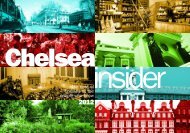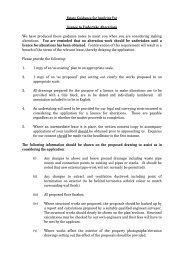Chelsea Insider Low - Cadogan
Chelsea Insider Low - Cadogan
Chelsea Insider Low - Cadogan
- No tags were found...
You also want an ePaper? Increase the reach of your titles
YUMPU automatically turns print PDFs into web optimized ePapers that Google loves.
20 | STREETS & SIGHTS |during the Second World War. Parts ofthe hospital were also damaged bybombs in 1918, rebuilt in 1923 anddestroyed again by a V2 rocket in 1945.The Margaret Thatcher Infirmary with its125 en suite bedrooms, built by QuinlanTerry, was opened in 2009 to providestate-of-the-art care.The creation of the <strong>Chelsea</strong>Embankment resulted in the loss ofWren’s original formal gardens, and theRoyal Hospital has lost and gained landover the years. Today, the grounds cover66 acres.The <strong>Chelsea</strong> Pensioners’ Appeal, aregistered charity, is campaigning to raise£30 million to update the living accommodationin the Long Wards, which arealready being refurbished, hoping tochange wooden cubicle berths andshared bathrooms into modern en-suitestudy bedrooms. (For more informationabout visiting the Royal Hospital<strong>Chelsea</strong>, see Museums and GreenSpaces.)• For the National Army Museum, seeMuseums.• For the <strong>Chelsea</strong> Physic Garden, seeGreen Spaces.• For Restaurant Gordon Ramsay andFoxtrot Oscar, see Restaurants.Sloane SquareSloane Square was part of the 1771Hans Town development designed byHenry Holland and his son, also calledHenry, and named after Sir Hans Sloane(see Hans Town panel on page 23). Inthose days, it had a small green in thecentre and Blandel Bridge crossed theRiver Westbourne in the eastern corner.The bridge was known as 'the bloodybridge’ because it was a notorious spotfor highwaymen, muggings and murders.Many of the premises in this area wereutilitarian in nature at first.By the 19th century, roads had sprungup to connect the surrounding streets.Sloane Square station opened in 1868(see Sloane Square Station) and PeterJones was created when draper PeterRees Jones opened shops at the topend of King's Road, redeveloping themas a single building in the 1880s (seePeter Jones in Shopping). The buildingthat houses the Royal Court Theatre wasbuilt in 1888 (see Royal Court Theatrein Theatre).The Venus Fountain at the centre ofthe square is Grade II-listed and wassculpted by Gilbert Ledward. It wasinstalled in 1953 and shows a kneelingVenus pouring water from a conch shell,while the basin depicts Charles II and hismistress, actress Nell Gwyn.Several proposals to redevelop thesquare have been put forward in recentyears. A public consultation was held in2007 about changes to the road layout,including a plan to create a crossroads.However, the plans were not popular anda renovation of the square was carriedout instead.Sloane Square StationSloane Square Station serves the Districtand Circle Underground lines and is onthe south-eastern corner of the Square,next to the Royal Court Theatre. The stationwas opened in 1868 as part of theDistrict line.The River Westbourne, one ofLondon’s ‘lost rivers’, flows above thetracks in a pipe on its way from itssource at Hampstead Heath to theThames at <strong>Chelsea</strong> Hospital.The station was rebuilt in the late 1930sbut it was heavily bombed in the SecondWorld War. In November 1940, bombsfell on the station causing the roof to collapsewhile a train was at the platform,killing or seriously injuring 79 people.Another tragedy at the station was thedeath of Peter Llewelyn Davies, theinspiration for JM Barrie’s Peter Pan, whocommitted suicide on the tracks.Holy TrinitySloane SquareDespite being known as Holy Trinity SloaneSquare, this church is actually on Sloane Street.One of London’s most beautiful buildings, itwas built in 1888 by John Dando Sedding, anarchitect inspired by the Arts and Crafts movement,which promoted skilled, hand-craftedwork as a reaction to industrialisation.The church was described by poet JohnBetjeman as “the cathedral of the Arts andCrafts movement”, featuring works by WilliamMorris, Edward Burne-Jones and ChristopherWhall, among others.The roof was destroyed by incendiary bombsduring the Blitz, but the church was restored bythe 1960s. The beautiful stained-glass windows,made by William Morris & Co, Sir WilliamBlake Richmond and Christopher Whall, havebeen returned to their former glory and areonce again a showcase for the Arts andCrafts style.Music is very important at Holy Trinity –Sedding himself was an organist, so the churchwas designed with a huge organ chamber morethan 40ft high. The Sunday morning servicesinclude music and there are often concerts heldat the church.The restoration of the organ began in July2011, funded by the <strong>Cadogan</strong> family and<strong>Cadogan</strong> Estates Ltd. The original was built byJames John Walker and completed in 1891. Ithas been modified and repaired many timessince then, including an unfortunate incident in1967 when a member of staff fell into the secondlargest pipe while replacing glue on thejoints (he survived). The rebuilt organ, which willhave a completely new structure and mechanismwhile retaining most of the historicpipework, is expected to be completed in latesummer 2012. Made by Harrison & Harrisonorgan builders, it will have 4,200 pipes, rangingfrom three-quarters of an inch to 32 feet.For more information, telephone 020 77307270 or visit www.holytrinitysloanesquare.co.uk.







